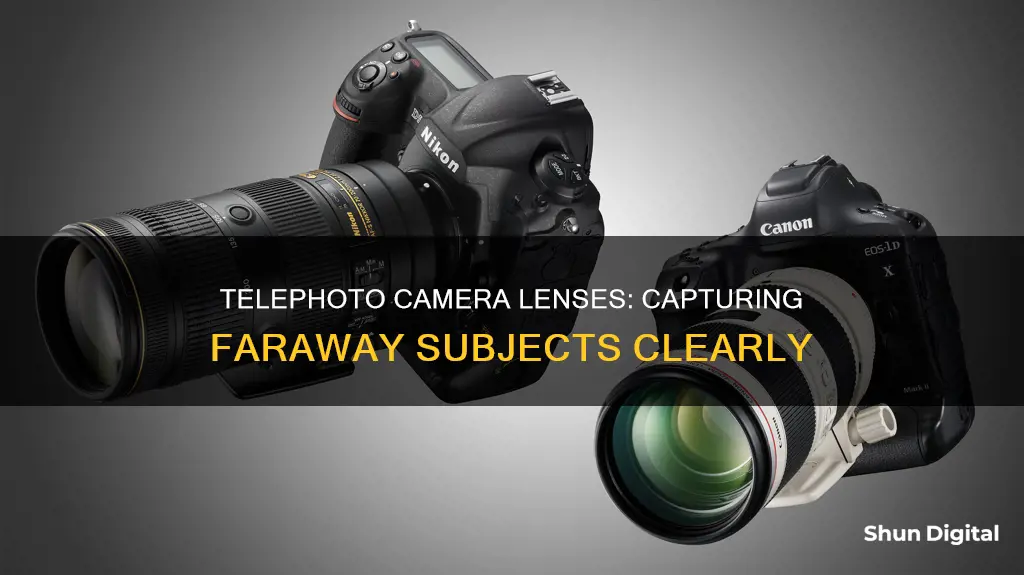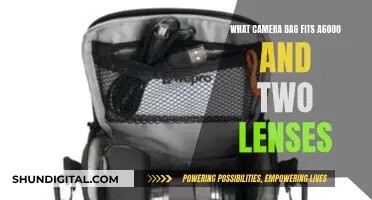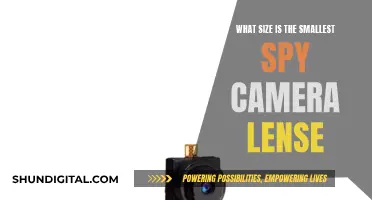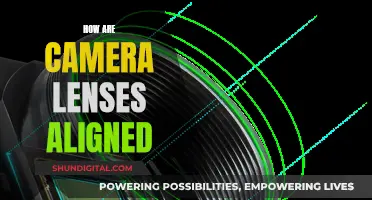
Telephoto lenses are a type of camera lens used in photography and cinematography. They are designed for taking photos of subjects at moderate to far distances, such as wildlife, sports events, and portrait photography. They have a physical length shorter than the focal length, which is achieved by incorporating a special lens group known as a telephoto group that extends the light path. This results in a long-focus lens with a compact design. The longer focal length of telephoto lenses makes them ideal for bringing distant scenes and subjects closer, creating a narrow field of view. They come in both prime (fixed focal length) and zoom varieties, with focal lengths typically starting at 85mm and going up to 800mm or more.
What You'll Learn

Telephoto lenses are used for photographing wildlife
Telephoto lenses are an essential tool for wildlife photography, allowing photographers to capture stunning images of animals in their natural habitats from a safe and respectful distance. These lenses bring faraway subjects closer, making them ideal for photographing wildlife, especially timid or dangerous animals.
Telephoto lenses are characterised by their longer focal lengths, which enable photographers to "zoom in" on distant scenes and subjects. They come in two main types: prime (fixed focal length) and zoom. While prime lenses offer superior image quality and speed, zoom lenses provide greater versatility and affordability. When choosing a telephoto lens for wildlife photography, it is crucial to consider factors such as focal range, aperture, durability, and compatibility with teleconverters to ensure you can capture crisp, clear images of wildlife in their natural environment.
The ideal focal range for wildlife photography is typically 400mm or greater, as it allows photographers to maintain a safe distance from their subjects. This longer focal length also helps capture intimate portraits of animals without disturbing their natural behaviours. Additionally, a longer focal length can result in a shallower depth of field, creating a pleasing background blur that isolates the subject and draws the viewer's attention.
Aperture is another critical factor when selecting a telephoto lens for wildlife photography. A wider aperture, such as f/2.8 to f/4, allows more light to enter the lens, resulting in faster shutter speeds and improved focusing speed. This is particularly advantageous when photographing fast-moving subjects, ensuring you don't miss fleeting moments. However, lenses with wider apertures tend to be more expensive.
When photographing wildlife, it is essential to consider the durability of your equipment. Opt for lenses made with high-quality materials, such as metal, and ensure they are weather-sealed to withstand various outdoor conditions. This adds weight to the lens but provides peace of mind when shooting in challenging environments.
Lastly, consider using teleconverters to extend the focal length of your telephoto lens even further. Teleconverters like the 1.4x, 1.7x, and 2x can increase the focal length of your lens, providing even greater reach for capturing distant subjects. However, using a teleconverter also increases the maximum aperture, which can affect image quality in low-light conditions.
In conclusion, telephoto lenses are indispensable tools for wildlife photographers, offering the ability to capture intimate portraits of animals in their natural habitats without disturbing them. By choosing the right focal range, aperture, and lens durability, as well as utilising teleconverters, photographers can effectively utilise telephoto lenses to create stunning and impactful wildlife images.
Affordable Camera Lenses: Brands Offering Cheaper Options
You may want to see also

They are used for sports photography
Telephoto lenses are an essential tool for sports photography. They are long-focus lenses that bring distant scenes and subjects closer, making them ideal for capturing sports events where the photographer is positioned at a distance from the action. This ability to get closer to the scene without physically moving is particularly useful in sports photography, as it allows photographers to get in on the action and capture key moments without disturbing the athletes or the flow of the game.
Telephoto lenses are also advantageous in sports photography due to their ability to create a shallow depth of field. This feature helps to blur the background, softening the surroundings and highlighting the athletes in the foreground. This technique is especially effective in sports photography as it allows the photographer to isolate the athletes from the often-distracting backgrounds of sports venues, creating iconic images that capture the magic moments of the game.
The specific telephoto lens chosen for sports photography will depend on the sport being covered and the photographer's position. For example, sports such as football, baseball, and soccer typically require longer focal lengths, such as 400mm or 500mm prime lenses, to capture the action from a distance. On the other hand, sports like tennis and basketball may allow photographers to get closer to the action, making shorter focal-length prime lenses or zoom lenses a better choice.
Additionally, the aperture of the telephoto lens is an important consideration in sports photography. A wide aperture is crucial for achieving fast shutter speeds, which are necessary for capturing sharp, action-stopping images. It also helps to blur busy backgrounds and yield the fastest shutter speed/lowest ISO setting combinations. When shooting outdoors, an aperture of f/5.6 or wider is generally sufficient, while an aperture of at least f/2.8 is ideal for low-light conditions or when shooting under the lights.
In conclusion, telephoto lenses are invaluable in sports photography as they enable photographers to capture crisp, dynamic images of athletes in motion, from a distance, with a blurred background that draws attention to the subject. By selecting the appropriate telephoto lens based on the sport, their position, and lighting conditions, photographers can effectively showcase the excitement and intensity of sporting events.
Camera Lenses: Retaining Value Over Time?
You may want to see also

They are used for astrophotography
Telephoto lenses are used in astrophotography to capture distant celestial objects. They are a specific type of long-focus lens, where the physical length of the lens is shorter than the focal length. This design allows telephoto lenses to bring distant scenes and subjects closer, making them ideal for astrophotography.
Telephoto lenses are available in three categories: short telephoto, medium telephoto, and super telephoto. Short telephoto lenses range from 85mm to 135mm and are great for everyday use due to their compact size and lightweight design. Medium telephoto lenses offer focal lengths between 135mm and 300mm, making them bigger, longer, and heavier. Super telephoto lenses provide focal lengths beyond 300mm and offer telescope-like magnification, but they are too heavy for handheld shooting.
When choosing a telephoto lens for astrophotography, it is important to consider the aperture, as a fast maximum aperture is critical for capturing clear and sharp images of the night sky. A wide aperture allows more light to enter the lens, enabling shorter shutter speeds and reducing the risk of star trails. Additionally, it is essential to minimise distortion and aberration to maintain the shape of stars in the final image.
Astrophotographers often use telephoto lenses in combination with star trackers, which compensate for the rotation of the Earth, allowing for longer exposure times without star trailing. This technique, known as "shooting longer with a star tracker," involves mounting the telephoto lens on a star tracker and polar aligning its axis to the celestial pole. This setup enables astrophotographers to capture distant nebulae and other deep-sky objects with remarkable clarity.
While telescopes are specifically designed for observing and photographing celestial objects, telephoto lenses offer versatility and can be used for both daytime photography and astrophotography. With their ability to bring distant objects closer, telephoto lenses are a valuable tool for anyone interested in capturing the beauty of the night sky.
Understanding Camera Lenses: A Beginner's Guide to Photography
You may want to see also

They are used for portrait photography
A telephoto lens is a specific type of long-focus lens used in photography and cinematography. The physical length of the lens is shorter than its focal length. This is achieved by incorporating a special lens group, known as a telephoto group, which extends the light path to create a long-focus lens in a shorter overall design.
Telephoto lenses are often used for portrait photography. They are ideal for capturing flattering portraits without distortion, magnifying details, and creating a beautiful background with bokeh. Portrait photographers can use telephoto lenses to really hone in on a particular feature of their subject's face.
Telephoto lenses are also used to create compression in an image. This 'compacts' or 'compresses' space, making objects in the foreground, middle ground, and background seem to stack up behind each other. This can be useful for portrait photography, as it makes the subject look smaller and the background larger.
Telephoto lenses are also used to create blurred backgrounds in portrait photography. Using a shallow depth of field with a telephoto lens can create a nice background blur. This isolates the head and face or body of the subject from unnecessary background details.
Telephoto lenses are available in a range of focal lengths, including 70-200mm, 85mm, 105mm, and 135mm. These lenses are often used for portraits, as well as for weddings, sports, and wildlife photography.
Understanding Camera Lenses: Types and Their Uses
You may want to see also

They are used for landscape photography
A telephoto lens is a type of long-focus lens used in photography and cinematography, where the physical length of the lens is shorter than its focal length. In other words, it has a focal length longer than 50mm.
Telephoto lenses are used for landscape photography to isolate objects and other details within the landscape, with a much narrower depth of field. They are great for more intimate scenes, where the focus is on shape and form rather than large, far-reaching vistas. They can be used to make a distant subject appear closer in the frame, as well as to fill the frame in a meaningful way.
- Use a tripod to stabilise your telephoto lens and reduce the risk of camera shake.
- Increase the ISO to compensate for the weight and size of the telephoto lens, which can cause movement.
- Focus with Live View to ensure a sharp focus, as telephoto landscape photography is all about the details.
- Use a remote shutter release to trigger the camera's shutter without physical contact, reducing camera shake.
- Turn on image stabilisation to reduce the risk of blurry images caused by camera shake.
- Select a mid-range aperture to ensure an adequate depth of field and the sharpest images.
- Compress the scene to bring the background closer to the foreground, creating a sense of scale.
- Don't frame too tightly to avoid reducing the impact of your images and making objects appear cut off.
Understanding Millimeters in Canon Camera Lenses
You may want to see also
Frequently asked questions
A telephoto lens, also known as a tele lens or long lens, is a type of long-focus lens used in photography and cinematography. The physical length of the lens is shorter than its focal length.
There are three types of telephoto lenses: short telephoto, medium telephoto, and super telephoto. Short telephoto lenses range from 85mm to 135mm, medium telephoto lenses range from 135mm to 300mm, and super telephoto lenses are 300mm and above.
Telephoto lenses are commonly used for photographing distant subjects such as wildlife, sports events, and portraits. They are also used in cinematography to get closer shots of subjects that are far away.
Telephoto lenses offer a longer focal length, allowing photographers to get closer to distant subjects without physically moving. They also provide a narrower depth of field, creating a more intimate image with a pleasing, natural perspective.







